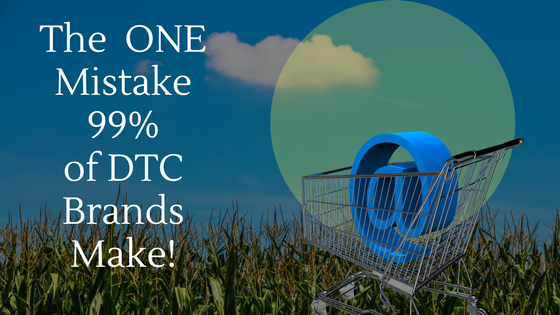
The One Mistake 99% of Direct to Consumer Brands Make
99% of startups and established brands believe that their Direct to Consumer business will grow naturally by just creating an ecommerce site. They start to drool thinking about the margins they will make by cutting out the distribution middlemen and retailers. But many make a big mistake. They assume that…
“If you build it, they will come.”
Unfortunately, DTC is not a field of dreams.
It takes a ton of work to drive traffic, convert shoppers to purchasers, and nurture loyal repeaters.
Many brands believe they can instantly replicate the spectacular success Dollar Shave Club, Casper, and AirBnB have had. What most don’t understand is the extreme investments these brands made, and the intense focus these brands trained on three key elements: traffic, conversion rate, and lifetime value. Having a great product may be fine and dandy, and a charismatic leader can certainly help garner a community following, but at the end of the day, ecommerce is really about a brand’s ability to attract interested customers and convert.
My DTC Equation
Being an ex-Purdue engineer, I have a tendency to think in mathematical models for systems. Here’s my simplified “equation” for DTC:
(T x CR)^LTV
- “T” represents the traffic driven to an ecommerce site by various channels such as social media, organic search, and direct to website traffic
- “CR” is the conversion rate, or the percentage of those visitors that purchase.
- “LTV,” or Lifetime Value, is the long term value of a consumer driven mostly by repurchase.
In separate posts, I will spend time breaking down the factors for each of these elements, but for now will give a brief explanation so that you can understand how they fit together.
Traffic
Traffic is the number of individuals landing on your ecommerce site. If you are a well known brand that has been in the market for years, like Tide or Apple, you may have the benefit of organic traffic from people simply googling your name.
For most brands, where brand awareness can be less than 5%, you need to deliberately bring in traffic to your site. This means getting in front of people that are likely to buy your product, and doing what it takes to get them to your website. For example, this may be achieved by partnering with a blogger or creating targeted social media ads.
And you cannot just think about getting someone to visit your site one time. Contact needs to be repeated over time. When I was working on my pet food start-up, the data showed that the average shopper needed to come into contact with our brand 10 times before actually making at purchase.
Conversion Rate
Conversion rate is a measurement of how effectively you are moving shoppers visiting your site or clicking through your marketing tactics to actually purchase your product. Conversion can be affected by a great number of factors including how easy is it to navigate a site, the relevance of promotions that drive a sense of urgency, and the trust and brand equity you may have built with individual shoppers.
The ecommerce team for the DTC retailer needs to continuously work to improve conversion rates, testing new site funnels, creative for promotions, and new marketing tactics. As the effectiveness of a sales funnel change much more quickly than in brick & mortar, improving the sale funnel is a constant activity that deserves dedicated resources.
Lifetime Value
Lifetime value, or LTV, is the third critical element of the equation, and is shown in a way that devotes the most “power.” Now that you have invested in getting a shopper to your site and converted them to being a trialist or purchaser of your product, you need to make sure they come back for more.
Most DTC brands have a financial model that only is profitable with multiple purchases. They assume they may lose profit on the first purchase, but make out on the second, third, or even sixth purchase.
The elements that drive repeat purchasing are varied. For subscription companies like Dollar Shave Club and NatureBox, the initial purchase is a subscription, which makes repurchasing automatic.
Some companies work hard to make the customer experience past the point of purchase as delightful and risk-free as possible. Zappos was known for how they make the experience easy with free shipping, free returns, and 24/7 customer service.
Other companies have continuous marketing and clubs with customers to remain top-of-mind. Bodybuilding.com is know for the community and knowledge base it creates that creates value for the shopper beyond a one-time purchase of their protein powders and supplements.
Many DTC sites drop the ball on the LTV component. They treat purchases as discrete events, and don’t put in place a comprehensive plan to drive repeat and loyalty.
For subscription companies that may put 3-10X the revenue of the first few purchases into marketing, attracting the right customers for the first purchase is important. It is important to not spend on shoppers that have no intention on sticking with a brand long-term, if that is the only way you will be profitable on an individual level.
Pulling it all together
Traffic, Conversion Rate, and Lifetime Value are the three components of the path-to-purchase that a direct-to-consumer brand needs to always be tracking and refining. There are many in-process measures that ladder up to these three, but these three are the key performance indicators that are the foundation of a sound DTC strategy.
Key Takeaways
- Many brands believe they can become overnight successes online like Dollar Shave Club. What most don’t understand is the extreme investments successful brands must make, and the intense focus on three key elements: traffic, conversion rate, and lifetime value.
- Traffic is the number of individuals landing on your ecommerce site. For most brands, where brand awareness can be less than 5%, you need to deliberately bring in traffic to your site. Contact must be repeated over time.
- Conversion rate is a measurement of how effectively you are moving shoppers visiting your site or clicking through your marketing tactics to actually purchasing your product.
- Lifetime value, or LTV is measurement of how often a shopper returns to repurchase. It is important to not spend on shoppers that have no intention on sticking with a brand long-term, if that is the only way you will be profitable on an individual level.

Keith Johnson
Keith Johnson is a corporate strategist and innovation expert. Keith spent the first half of his career with Procter & Gamble in the US, Europe, and Asia, with a focus on growing brands through technical and commercial innovation. Most recently with Catalina Marketing, Keith worked to innovate shopper marketing for top consumer product companies through digital promotions and advertising. A serial entrepreneur, he founded and grew a breakthrough ecommerce company and launched a digital marketplace startup. Keith serves as an alumni leader for the University of Chicago Booth School of Business.
Today, Keith is the Founder & Principal of Brilliant Ecom!. Brilliant Ecom! helps brands understand what is happening in their category online, set a solid e-commerce strategy, and provide infrastructure to handle the most critical yet manpower-intensive elements to drive sales.


